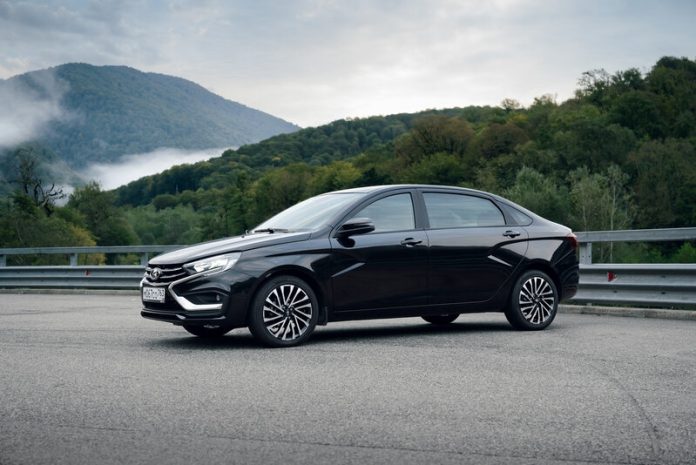Attempts to make limousines or long versions from VAZ models have periodically arisen at different times. Extended Lada models have always been a curiosity and something unusual. The next variation of the extended sedan based on the Lada Vesta appeared at a difficult time for the country. “Yuzhny Avtomobil” went for a test drive of the Lada Aura and found out what is good about the new business sedan and why it is a separate model, and not the Lada Vesta Long.

The first attempts to make long versions from the Lada began back in 1996, when the extended VAZ-21109 “Consul” sedan was produced to individual orders at the Togliatti plant. The stretched “ten” for private individuals was produced in small runs until 2006. Then the topic of stretching VAZ sedans was postponed for almost ten years. They remembered about it in 2015, when four Lada Vesta Signature sedans were built on the basis of Lada Vesta. But those were awkward experiments, more like tuning. Now, on the basis of Lada Vesta, a full-fledged D-class sedan was created without body cuts and additional spacers.


The model was named Lada Aura and separate stamps were purchased for the production of its bodies. Thus, the new product is positioned not as a Lada Vesta stretched by 25 centimeters, but as a separate model, but unified with it in units and assemblies. The buyers of the car will be officials, various departments and taxi companies. AvtoVAZ promises to sell part of the circulation to individuals.

The boss’s place
AvtoVAZ made it clear to journalists that the main place in the Lada Aura is not behind the wheel, but on the back seat. The car was created with an eye on those who will ride in the back. If we compare the new product with the Lada Vesta, then the Aura has 244 new parts. The roof and doors are stamped at the plant as a whole, and not welded in parts. The only insert is on the bottom of the car. With such simple manipulations, the Lada Vesta turned into the Lada Aura.

 I open the wide rear door and find myself on the rear sofa covered with high-quality domestically produced nappa leather. The interior trim can be black or white. The ceiling in the car is white fabric. For versions with a black interior, the ceiling could be covered with black fabric or at least Alcantara. It is not so expensive to produce, but it would look more solid and richer.
I open the wide rear door and find myself on the rear sofa covered with high-quality domestically produced nappa leather. The interior trim can be black or white. The ceiling in the car is white fabric. For versions with a black interior, the ceiling could be covered with black fabric or at least Alcantara. It is not so expensive to produce, but it would look more solid and richer.

Reinforced hinges are installed under the massive doors, and they themselves open to a wider angle. In the open position, these huge “gates” can be fixed at an angle of 22, 42 and 67 degrees. The doors close nobly with a heavy slam. All thanks to the additional sound insulation.
The rear sofa has remained from the Lada Vesta for now, but soon AvtoVAZ promises versions with seats similar to those installed in the luxury Aurus models. With my height of 174 cm, sitting on the rear sofa is comfortable and spacious. There is no backrest tilt adjustment, which was complained about by tall fellow journalists during the test drive. Supposedly, the back gets numb. But I find it quite comfortable to sit. I also liked the cushions on the headrests, the same ones are found in more expensive and premium cars from unfriendly countries. Such cushions are planned to be sold as a separate accessory, so that they can be installed on almost any Lada model.
The official cars will have a leather interior, but the Lada Aura taxi version will have a fabric interior. In general, along with the Aurus-style seats, it would be nice to provide the rear passengers with folding tables, air deflectors, and even ottomans. The passenger has only one USB slot and single-stage seat heating. The driver has three-stage heating, so it turns out that the boss was shortchanged a little. The light interior in the Aura looks more elegant, but it is not a fact that it will be more practical. It was also possible to add color variations for the leather. The interior would also look good in brown or red.

Driver’s seat
Behind the wheel, it’s still the same Lada Vesta, although this steering wheel is covered with expensive leather. In a two-tone design, the steering wheel looks more stylish than a pure black one. Electric adjustments for the driver’s seat never appeared, just as there is no climate control in the Lada Aura. So far, the car is equipped with air conditioning, but climate control is promised already in 2025.

In the center is a large 10-inch tablet of the Lada Enjoy Pro multimedia system with support for Yandex services and the Alice voice assistant. Such a tablet will only be available on the top-end Lada Aura; the car will receive a seven-inch touchscreen as standard. There are no complaints about the driver’s seat. You can comfortably sit behind the wheel, however, it is also comfortable to sit behind the wheel of the Lada Vesta.

On the move
While driving, the Lada Aura is pleasantly different from the Lada Vesta. First of all, the cabin is much quieter due to improved sound insulation. However, in the mountains, the combination of the CVT and the 1.8 EVO engine with 122 horsepower turned out to be quite noisy. During long climbs, the engine growls tensely. There are no complaints on straight sections. However, consumers will not use the Lada Aura in the mountains, and for urban and highway operating conditions, the car is not too noisy.

The stability control system and the long base have a positive effect on handling. The car is even more pleasant to drive than the Lada Vesta, and the ESC system catches all the driver’s mistakes. The ride was smoother than the Vesta. AvtoVAZ engineers reconfigured the suspension and installed other shock absorbers. They are configured for driving on both broken asphalt and a good road. The Lada Aura has 17-inch wheels with an original design – they look stylish.

How much does it cost
The Lada Aura has only two trim levels. The simple one is Premier, and the top one is Status. All versions have a 1.8 EVO engine, which works in tandem with a CVT from Eastern partners. A manual gearbox and a junior 1.6 engine are not expected. The car costs from 2.6 million rubles for the basic version and from 3 million for the maximum version. The main competitors are numerous Chinese cars, including Chery Arrizo 8, JAC J7, FAW Besturn B70 and the Russian-Chinese liftback Mokvich 6.

But if we take into account the fact that domestically produced cars are a priority for government purchases, then the only competitor for the Lada Aura is the Moskvich 6. In defense, I would like to say that the Lada Aura is a more understandable car for the domestic market and the driver, both in terms of operation and maintenance.
The car will definitely be profitable not only for officials, corporate fleets, but also when used in taxis. This is an inexpensive car to maintain. For example, the cost of maintenance for Lada Aura after 300,000 kilometers or three years of operation will cost 305,000 rubles. Owning and servicing a Chinese car will cost 1.5-2 times more.











